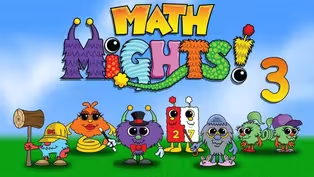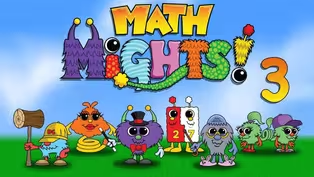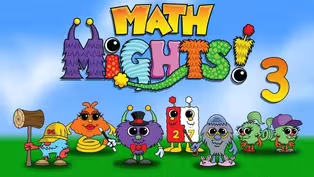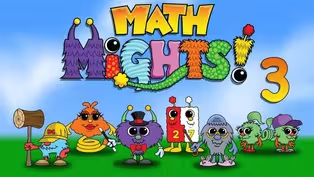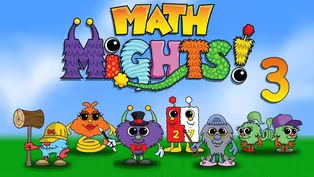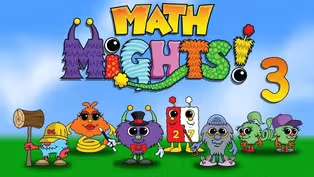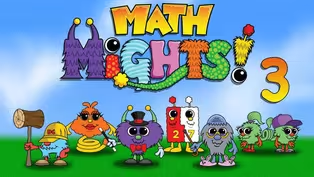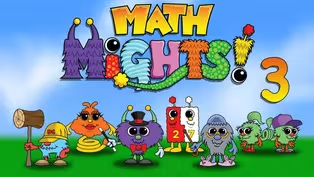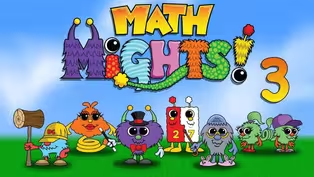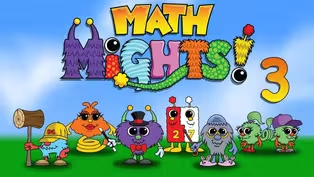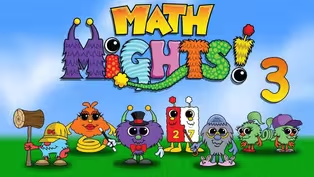Math Mights
Dividing with even larger numbers
Season 3 Episode 306 | 15m 59sVideo has Closed Captions
Join Ms. Askew and Professor Barble to do a visual model with multiplication.
Join Ms. Askew and Professor Barble to do a visual model with multiplication a word problem. Get ready to divide within 100, where the quotient or divsor is higher than 20.
Problems playing video? | Closed Captioning Feedback
Problems playing video? | Closed Captioning Feedback
Math Mights is a local public television program presented by Detroit PBS
Math Mights
Dividing with even larger numbers
Season 3 Episode 306 | 15m 59sVideo has Closed Captions
Join Ms. Askew and Professor Barble to do a visual model with multiplication a word problem. Get ready to divide within 100, where the quotient or divsor is higher than 20.
Problems playing video? | Closed Captioning Feedback
How to Watch Math Mights
Math Mights is available to stream on pbs.org and the free PBS App, available on iPhone, Apple TV, Android TV, Android smartphones, Amazon Fire TV, Amazon Fire Tablet, Roku, Samsung Smart TV, and Vizio.
Providing Support for PBS.org
Learn Moreabout PBS online sponsorshipMore from This Collection
Video has Closed Captions
Join Ms. Askew for a tricky multi-step word problem with Professor Barble! (15m 59s)
Build Fraction from Unit Fractions
Video has Closed Captions
Join Ms. Askew for another multi-step word problem with Professor Barble! (15m 59s)
Video has Closed Captions
Join Ms. Askew for a division word problem with her friend Professor Barble. (15m 59s)
Video has Closed Captions
Join Ms. Askew for a division word problem with her friend Professor Barble. (16m)
Video has Closed Captions
Join Ms. Askew and Professor Barble to do a visual model with a word problem. (15m 59s)
Video has Closed Captions
Join Ms. Askew and Professor Barble to see if you can match visual models to word problems (15m 59s)
Dividing with Larger Quotients
Video has Closed Captions
Join Ms. Askew and Professor Barble to see if you can match visual models to word problems (15m 59s)
Video has Closed Captions
Learn about multiplying one-digit whole numbers by multiples of 10. (15m 59s)
Video has Closed Captions
Learn about multiplying numbers larger than 20. (16m)
Video has Closed Captions
Join Mrs. Askew for a Number Talk with 2 Math Might Friends! (16m)
Multiply Teen Numbers with Larger Groups
Video has Closed Captions
Join Mrs. Askew for a Number talk with 2 Math Might Friends! (15m 59s)
Relating Multiplication and Division
Video has Closed Captions
Join Ms. Askew for a subtraction number talk with Springling! (16m)
Providing Support for PBS.org
Learn Moreabout PBS online sponsorship(bright music) - [Children] Math Mights.
- Welcome, third grade Math Mights.
I'm so excited to see that you've joined us today.
My name is Ms. Askew and I can't wait to have fun learning about math with you.
But first, let's take a look at our plan for today.
Today, we're going to work on our word problem with our friend Professor Barble.
After that, we're going to learn how to divide with larger numbers.
Before we begin, let's warm up our brains with Professor Barble as we conquer word problems using visual models.
Now, who is Professor Barble?
Professor Barble is a friend who lives in Mathville.
He likes to take hikes all throughout Mathville looking for story problems to solve.
Professor Barble knows that third graders sometimes go really fast and they want to try and solve the problem before knowing what it's all about.
His job is to slow us down.
He takes us through a step-by-step process that helps us think about what the problem is asking us so that we can have a better understanding of how to solve it.
He wears a thinking cap and he uses that to help him visualize a visual model to better understand what the story problem is asking.
You might be asking yourself, "What is a visual model?"
A visual model is sometimes known as a model drawing, unit bar, tape diagram, or bar model.
A visual model is a reading comprehension strategy for word problems.
Drawing a visual model helps to visualize the strategies and understand what the word problem is asking.
Abdul and Patrick have a word problem that they would like to conquer.
Let's read it.
Samantha brought five bags of gummy bears to school.
Each bag had 40 gummy bears.
How many gummy bears did Samantha bring to school?
Abdul thinks we should multiply.
Wait, no.
Patrick thinks we should divide.
Hold on you guys.
If Professor Barble heard us talking, he would say, "Wait a minute, you're already at step six.
You're trying to solve the problem.
Let's slow down and follow the step-by-step process to get a better understanding of what the story problem is asking us."
These seven steps will help you as a third grader to have a better understanding of what a word problem is asking.
Let's take a look at step number one.
Step one is to read the entire problem and put it into chunks.
Now, I'm going to read the story problem first, then after me, I would like you to read it and then we can put in our chunks.
Let's try it.
Samantha brought five bags of gummy bears to school.
Each bag had 40 gummy bears.
How many gummy bears did Samantha bring to school?
Now it's your turn.
Let's read the story problem again, but this time, let's put in the chunks.
Samantha brought five bags of gummy bears to school.
Chunk.
Each bag had 40 gummy bears.
Chunk.
How many gummy bears did Samantha bring to school?
Chunk.
Now, you might be asking yourself, "Ms. Askew, why did we chop those sentences?"
Well, third graders, when you take a step problem and you break it into smaller chunks, you get a better understanding of what the story problem is asking you to do.
Step two is to rewrite the question in sentence form with a blank space for the answer.
Samantha the brought, blank, gummy bears to school.
Writing out the question in sentence form slows down your thinking.
It helps you to not guess or jump ahead and try to solve the problem and really think about what it is you're trying to solve.
Now it's time to call in our friend Professor Barble.
He's going to put on his thinking cap so he can help us draw a visual model to help us better understand how to solve the problem.
Step three, we're going to determine the who and/or the what that's involved in the problem.
The gummy bears are the what problem.
Step four is to draw the unit bar.
We've drawn our unit bar and the unit bar represents the gummy bears.
Let's look at step five.
In step five, we're going to go back to the chunks and check when each part is added into the adjusted unit bars.
Put in the question mark.
Let's go back and look at our story problem.
The first chunk reads, Samantha brought five bags of gummy bears to school.
Now we're going to take our unit bar and divide it into five sections.
We want the five sections because they represent the bags.
Now that we've drawn our unit bar, let's go back to the story problem and check off that chunk.
The next sentence reads, each bag had 40 gummy bears.
We want to put 40 gummy bears in each bag.
Let's go back to our story problem and check off that chunk.
Finally, the question is, how many gummy bears did Samantha bring to school?
We don't know that yet, so that's the unknown.
We're going to put a question mark to represent that chunk.
Let's go back to our story problem and check it off.
As you can see, we have three checks for our three chunks.
Great job.
Now we're going to move on to step six, the fun part.
Correctly compute and solve the problem.
Patrick says, "I see, we need to multiply and not divide by looking at Professor Barble's visual model."
I have the multiplication problem, five groups of 40.
First I wanted to figure out how many total disks I have.
Now remember, the first factor represents how many rows, which is five.
One, two, three, four, five.
The second factor represents how many are in each row.
One, two, three, four.
So five groups of four equals a total of 20.
But each disk has a value of 10.
So I take the 20 total disks and multiply it by 10, and that's how I got my total of 200.
Now we're onto our final step, step seven.
Write the answer in the sentence and make sure the answer makes sense.
Five groups of 40 equals 200.
Samantha brought 200 gummy bears to school.
Excellent job, third grade Math Mights using Professor Barble's strategy of using a visual model to solve story problems.
Now let's check out our I can statement for today.
I can divide within 100 where the quotient or divisor is more than 20.
Let's do an estimation exploration.
What is a good estimate quotient four 84 divided by four?
What do you think would be a good estimate for that problem?
What would be a good estimate that would be too low, about right, and too high?
Abdul thinks 10 would be too low because if he did four groups of 10, it would only be at 40.
Abdul thinks that 10 groups of four would be too low.
10 groups of four equals 40.
If our target number is 84, I can see that 40 would be way too low.
Patrick says 25 would be too high because if he did four groups of 25, it would be at 100.
Let's take a closer look at Patrick's thinking.
25 groups of four equals 100.
That's way over our target number of 84.
Let's say about why 20 or 22 would be about right for the quotient.
Let's take a closer look using our whiteboard.
If we have 20 groups of four, that would be 80.
And 80 is just about 84.
So that means 20 or 22 could be a good estimate for 84 divided by four.
Great job, Math Mights taking what you know about division and multiplication and making a good estimate.
Now let's see how some of our friends solved another division problem.
Lin, Priya, and Tyler each found the answer a different way.
The problem is 78 divided by three.
It looks like Lin used place value blocks to split up 78 into three equal groups.
And we see from what she did, there are 26 in each of those groups.
It looks like Priya used multiplying up to solve the problem.
Tyler also used the multiplying up strategy to solve the problem, but in a different way.
Let's take a closer look using our whiteboard to get a better understanding of how they did that.
First lets look at how Priya solved the problem.
The problem is 78 divided by three.
Priya wanted to know, how many groups of three can we take from 78?
Priya knows that our friendly number is 10 and she knows that 10 groups of three equals 30.
She then took another group of 10 groups of three, and that equals 60.
What's left, only 18.
Then she thought, "How many groups of three are in 18?"
And that was six.
Then she added them all together.
10 plus 10 plus six equals 26.
Now, Tyler on the other hand used the same multiplying up strategy, but instead of doing groups of 10, he did 20.
He knows that 20 groups of three equal 60.
And that has 18 left.
How many groups of three are in 18?
Six.
So then he added the groups together.
20 plus six, and that also equals 26, just like Priya.
Lin, Priya, and Tyler solved the same problem in three different ways.
I wonder which way you came up with.
We just saw that you can solve using multiplying up but in different ways.
Let's take a look at another problem.
Let's solve this problem with Lin's way using base 10 blocks.
63 divided by three.
Let's act it out on the whiteboard.
We have our place value blocks here.
The dividend or the total number of blocks is 63.
We are already have our three groups, which is our divisor.
Now we're going to divide them equally among the three groups.
As you can see, we have 10, 20, one in each group.
So, 63 divided by three equals 21.
Third grade Math Mights, I know you are getting really good at solving division problems using place value blocks.
How about we try our problem using the multiplying up strategy?
Let's solve this with Priya's way of multiplying up.
96 divided by four.
As you can see, we have our friends Springling here to remind us that we can multiply up just like she does when counting on on an open number line when subtracting.
The problem is 96 divided by four.
The target number is 96.
Hmm.
How many groups of four are in 96?
I know a friendly multiplication fact.
10 groups of four.
10 groups of four equals 40.
So let's subtract out 40 from our total of 96.
Now that I see I have 56 left, that means I can subtract out another 10 groups of four.
Let's subtract that out from our total.
Now we have 16 left.
How many groups of four are there in 16?
Four groups of four equals 16.
Now we can subtract them out until there are none left.
Now we're going to add up how many groups of four we have altogether.
10 plus 10 plus four equals 24.
So, 96 divided by four equals 24.
Great job, Math Mights using multiplying up to solve that problem.
If you had the choice between using place value blocks or the strategy of multiplying up, which one would you use?
Let's see what strategy Abdul likes.
Abdul says, "I like multiplying up because it helps me understand the quotient."
Patrick says, "I like using the base 10 blocks to act out division problems."
As you can see from all the examples we've done, it might be easy to use base 10 blocks and other times it might be more useful to use the multiplying up strategy.
Now it's your turn to see if you can use your understanding of division to estimate and compare quotients.
Boys and girls, I had so much fun working with you today.
We hung out with Professor Barble and he showed us how to slow down to better understand how to solve story problems.
We also learned different ways to use multiplying up and place value blocks to solve division problems.
I hope you continue to work hard and practice so that you can get even better.
So I'll see you next time, and have a great day.
(upbeat music) - [Narrator] SIS4teachers.org, changing the way you think about math.
- [Narrator] This program is made possible with funding from the Michigan Department of Education, Governor's Education Emergency Funds, the state of Michigan, and by viewers like you.
(bright music)


- Home and How To

Hit the road in a classic car for a tour through Great Britain with two antiques experts.










Careers that Work

Support for PBS provided by:
Math Mights is a local public television program presented by Detroit PBS
